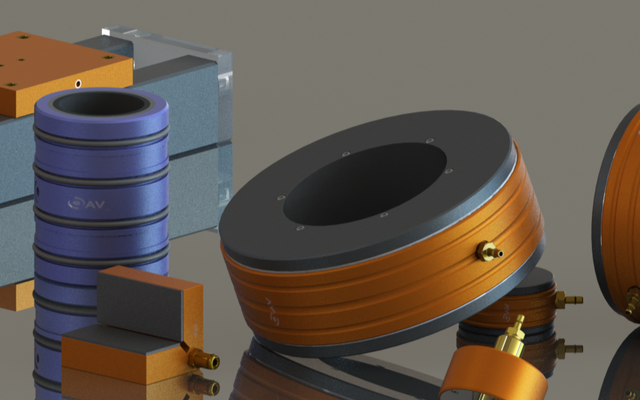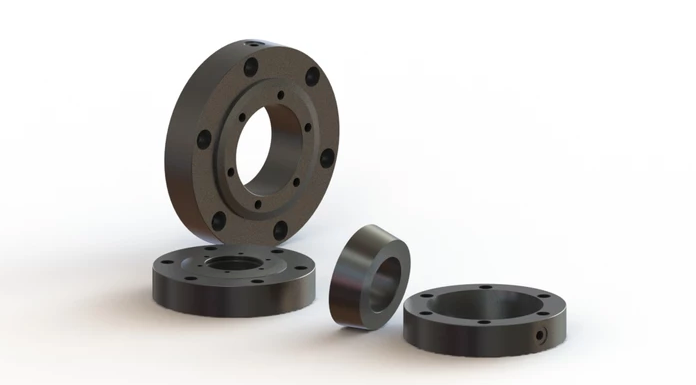In the ever-evolving world of precision manufacturing, the emphasis on accuracy, speed, and efficiency is paramount. Air bearings have emerged as a critical component in ensuring these attributes. Acting as the unsung heroes, these bearings bring about a transformation in the way machinery operates, ensuring the highest levels of precision and durability.
Table of Contents
What are air bearings?
Air bearings, fundamentally, are non-contact bearings that use a thin film of pressurized air to provide a zero friction load-bearing interface between surfaces. The cushion of air eliminates surface contact, ensuring a frictionless motion. Recognized for their significance in precision manufacturing, these bearings provide high precision, repeatability, and load capacity, all while offering virtually wear-free operation.
Why are air bearings used in precision manufacturing?
In the realm of precision manufacturing, the demand for tools and components that reduce friction, enhance speed, and maintain accuracy is paramount. Air bearings meet these requirements head-on, offering:
No Direct Contact: Ensuring zero wear and tear, leading to longer equipment life.
High Speed Capability: Reduced friction enables faster operations.
Enhanced Precision: Elimination of frictional inconsistencies ensures better product quality.
Clean Operation: No need for lubrication, ensuring a clean manufacturing environment.
Minimal Heat Generation: Reducing the risk of machinery overheating.
How do air bearings work?
Air bearings function by using compressed air to produce a thin film between the bearing surface and the object it supports. The mechanisms behind these bearings involve:
Preload: Ensures the bearing maintains its ultra-thin air film.
Load Capacity: Determines the maximum weight the bearing can support.
Stiffness: Reflects the bearing’s resistance to changes in its air film thickness.
What are the types of air bearings?

Various designs and configurations of air bearings cater to different applications. Understanding each type’s intricacies is crucial for their effective application.
Orifice air bearings
Employing small orifices to release air, they offer consistent performance but might consume more air compared to other types.
Porous air bearings
Made from porous materials, these bearings release air more evenly, ensuring a stable air cushion.
Grooved air bearings
These bearings utilize grooves to manage the air flow, often providing better stability under dynamic loads.
Aerostatic vs. Aerodynamic bearings
While aerostatic bearings rely on external pressure sources, aerodynamic ones depend on the relative motion between surfaces to generate pressure.
What sets air bearings apart from traditional bearings?
Both air and traditional bearings come with their unique advantages. However, the differentiation lies in:
Advantages of Air Bearings:
Zero friction: Providing smoother operations.
No wear and tear: Prolonging equipment life.
High precision and accuracy: Ensuring superior product quality.
Clean operation: No lubrication means a cleaner workspace.
H3: What are the limitations or challenges of air bearings?
While air bearings have their merits, challenges like:
- High initial setup costs.
- Sensitivity to surface contaminants.
- Need for constant air supply.
- Limited load capacity in some designs.
In what precision manufacturing applications are air bearings most commonly used?

Air bearings have found utility in various precision applications:
High-speed spindles: Where minimal friction and heat are essential.
Coordinate measuring machines (CMM): Requiring high levels of accuracy.
Semiconductor equipment: To ensure delicate operations are smooth.
Flat panel display equipment: Demanding precise movements without disturbance.
Precision turntables: Where stability and precision are key.
How do air bearings impact the overall efficiency and quality of a manufacturing process?
Air bearings play a transformative role by:
Enhancing overall machinery lifespan.
Reducing maintenance costs.
Ensuring consistent product quality.
Minimizing production downtimes.
How do air bearings contribute to achieving tighter tolerances?
Their ability to reduce frictional inconsistencies allows manufacturers to achieve tighter tolerances, ensuring each product meets the highest standards.
How do air bearings minimize vibrations in machinery?
Air film damping, inherent in air bearings, reduces vibrations, ensuring smoother operations and better product quality.
What are the design considerations when integrating air bearings into a system?
Key design considerations include:
Load capacity.
Size and form factor.
Integration with existing systems.
Air supply requirements.
Maintenance and troubleshooting of air bearings
Maintenance is crucial to ensure air bearings’ longevity. Common issues include:
Air supply inconsistencies.
Surface contamination.
Bearing misalignment.
How cost-effective are air bearings in the long run?
Considering longevity, reduced maintenance, and increased production efficiency, air bearings prove to be cost-effective in the long run despite higher initial investments.
What are the innovations and advancements in air bearing technology?
Research in air bearing technology focuses on improving efficiency, reducing air consumption, and increasing load capacity.
Are there any alternatives to air bearings in precision manufacturing?

While air bearings are unrivaled in many applications, alternatives include:
Fluid dynamic bearings.
Traditional mechanical bearings.
Rolling element bearings.
How do air bearings impact the overall efficiency and quality of a manufacturing process?
Air bearings are not just components; they’re catalysts that drive efficiency in precision manufacturing. Their unique design principles enable manufacturers to attain unparalleled levels of accuracy and repeatability.
Reduction in Downtime: With no wear and tear, the machinery operates flawlessly, minimizing interruptions.
Enhanced Product Quality: The elimination of friction means machines operate at their optimal best, ensuring each product meets strict quality standards.
Energy Efficiency: With minimal resistance, machinery operates with less energy, making the manufacturing process greener.
How do air bearings contribute to achieving tighter tolerances?
In an industry where a micron’s deviation can lead to significant losses, air bearings are the go-to solution. The absence of physical contact eliminates traditional issues associated with friction, such as heat generation, wear, and inconsistencies, ensuring machinery operates at its peak precision.
How do air bearings minimize vibrations in machinery?
The beauty of air bearings lies in the ‘air film damping’ phenomenon. This unique characteristic allows them to cushion and absorb shocks, ensuring that machinery operates without any vibrations, which is crucial for tasks demanding high precision.
What are the design considerations when integrating air bearings into a system?

Integrating air bearings requires meticulous planning and precision:
Compatibility: Ensuring that the air bearing’s design complements the machinery’s architecture.
Environment: A clean environment is crucial as contaminants can impact the thin air film.
Air Quality: The supplied air should be free from impurities and moisture.
Stability: Ensuring that the machinery remains stable during operations.
What are the key installation tips for air bearings?
Professional Supervision: Always have an expert oversee the installation.
Follow Manufacturer’s Guidelines: Each bearing type might have specific installation instructions.
Regular Testing: Once installed, regular tests should be conducted to ensure optimal performance.
Maintenance and troubleshooting of air bearings
While air bearings require minimal maintenance, it’s crucial to be aware of potential issues:
Regular Inspection: For signs of damage or air leakage.
Ensure Optimal Air Supply: A consistent air supply is vital.
Alignment Checks: Misalignments can impact performance.
How cost-effective are air bearings in the long run?
When analyzing the ROI of air bearings, one must look beyond the initial investment:
Reduced Maintenance Costs: With no wear and tear, the costs associated with replacements and repairs plummet.
Energy Savings: Enhanced efficiency translates to reduced energy bills.
Improved Product Quality: Better products mean happier customers and fewer returns.
What are the innovations and advancements in air bearing technology?

The world of air bearings is continually evolving:
Material Innovations: The use of advanced materials to enhance durability and performance.
Design Improvements: Designs that optimize air flow and enhance load capacity.
Integration with AI: Smart bearings that can self-diagnose issues and optimize performance.
Are there any alternatives to air bearings in precision manufacturing?
While air bearings are exceptional, there are alternatives:
Magnetic Bearings: Use magnetic fields to levitate moving parts, eliminating contact.
Piezoelectric Bearings: Rely on the piezoelectric effect to create motion.
Hydrodynamic Bearings: Use lubricating fluids to create a film between moving parts.
Conclusion
In the intricate ballet of precision manufacturing, air bearings play the lead role. They ensure the dance of machinery occurs flawlessly, with each move executed with unmatched precision. As industries evolve and the demand for perfection grows, air bearings stand as the epitome of manufacturing excellence.





